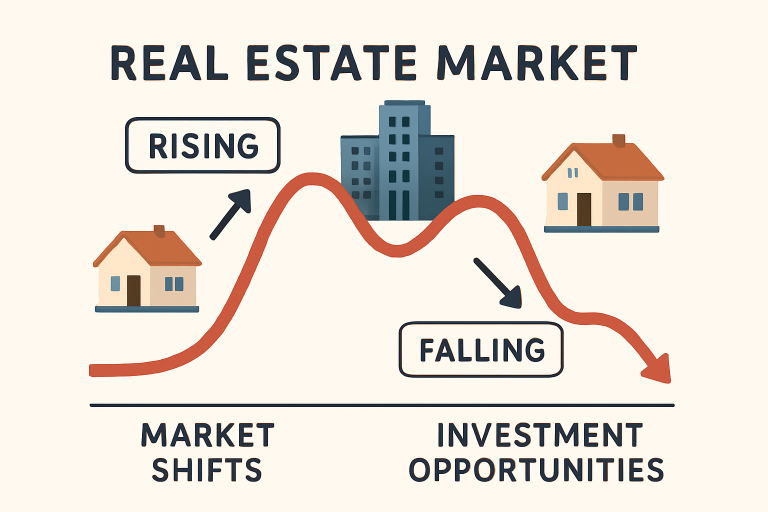Navigating the volatile terrain of today’s property market requires both adaptability and strategic planning. As global and local factors continue to influence real estate dynamics, savvy investors are seeking fresh approaches to stay ahead. Whether you are expanding your portfolio or entering new territories, collaborating with area experts like Aspen CO real estate agents Aspen Luxury Brokers can help guide informed, opportunity-driven choices. Establishing relationships with market leaders and utilizing robust investment frameworks have never been more crucial.
This comprehensive guide explores time-tested and emerging strategies to bolster your real estate portfolio amid fluctuating conditions. From market analysis to passive investment options and demographic shifts, discover how to position your holdings for both resilience and profitability.
Understanding Market Shifts
Real estate markets fluctuate due to a combination of economic cycles, changes in interest rates, labor market trends, and unique local factors. Investors should differentiate between cyclical shifts, which reflect short-term market corrections, and structural shifts, often triggered by technological innovation, demographic changes, or policy reforms.
- Cyclical Shifts: These are often marked by transitions between buyers’ and sellers’ markets. Early identification enables timely repositioning and risk management.
- Structural Shifts: Developments such as remote work, urban migration patterns, or legislative changes can permanently alter where and how people invest and live.
Staying aware of both macro and micro trends allows investors to anticipate downturns and capitalize on new opportunities. Periodic reviews of sources like the National Association of Realtors’ research equip investors with actionable data for strategic decision-making.
Diversifying Your Portfolio
Diversification mitigates risk and maximizes opportunity by spreading investments across property types, regions, and strategies. Three primary forms of diversification include:
- Property Types: Balancing holdings among residential, commercial, and mixed-use real estate safeguards your portfolio against industry-specific losses.
- Geographical Diversification: Investing in multiple markets—urban, suburban, and rural—reduces vulnerability to localized economic downturns or regulatory changes.
- Investment Approaches: Combining traditional buy-and-hold with options like short-term rentals or REITs introduces different risk-return profiles and income streams.
A well-diversified portfolio is better equipped to absorb shocks and capitalize on market rebounds, positioning investors to thrive regardless of broader trends.

Leveraging Technology
Advanced digital tools transform how investors analyze the market, manage properties, and engage clients. Key innovations include:
- Market Analysis Tools: Platforms like Zillow Research and CoStar Market Analytics deliver real-time market insights, helping investors predict price trends and evaluate opportunities more accurately.
- Property Management Software: Integrated solutions streamline rent collection, maintenance tracking, and tenant communications, reducing operational inefficiencies.
- Digital Marketing: Social networks and search engine advertising enable targeted outreach, enhancing visibility and attracting ideal tenants or buyers.
Investors who embrace technology not only optimize efficiency but also stay competitive in a rapidly evolving marketplace.
Focusing on Sustainable Investments
Demand for eco-conscious properties continues to rise, making sustainability a deciding factor for future-focused investors. Buildings with features like energy-efficient appliances, LEED certification, and renewable energy systems command higher valuations and tenant interest.
- Eco-friendly upgrades often result in government incentives and rebates.
- Lower utility and maintenance costs benefit both owners and tenants.
- Properties with green certifications are increasingly attractive in competitive rental and sales markets.
Integrating sustainability into your investment approach not only aligns with environmental responsibility goals but can also yield financial advantages.
Exploring Emerging Markets
New investment frontiers—often found in secondary cities or underdeveloped downtown districts—are drawing increased attention. These markets offer lower entry points and the potential for high appreciation.
- Population migration towards affordable cities drives rental demand and infrastructure growth.
- Regions undergoing revitalization or benefiting from public/private redevelopment projects often present prime investment windows.
Comprehensive research, supported by localized data and expert guidance, is key to identifying high-yield opportunities while navigating regulatory or market-specific risks.
Embracing Passive Investment Options
Passive real estate investments free investors from the burdens of hands-on management. Notable options include:
- REITs: Offer affordable entry into diversified, income-generating portfolios.
- Crowdfunding Platforms: Companies like Fundrise allow investors to join forces on large projects, distributing risk and increasing access to specialized assets.
These vehicles provide flexibility, liquidity, and reduced barriers to entry, making real estate accessible to a broader pool of investors.
Adapting to Demographic Changes
Tracking shifts in demographics sharpens your investment edge. Millennials, for instance, continue to drive urban rental demand, while Baby Boomers fuel growth in retirement and multifamily developments.
- Millennials: Prioritize flexibility and urban lifestyle amenities, boosting demand for rentals in revitalized city centers.
- Baby Boomers: Prefer low-maintenance housing in walkable communities, often seeking features that support aging in place.
- Generation Z: Begin to shape first-time homebuyer and urban rental market trends.
Aligning investment strategies with these evolving preferences ensures both stable cash flow and long-term portfolio relevance.
Conclusion
Real estate investing in shifting markets necessitates an agile, informed, and diversified approach. By embracing technology, seeking out sustainable or emerging market investments, adapting to demographic evolution, and utilizing passive investment vehicles, investors can position their portfolios for both immediate returns and future growth. Maintaining flexibility and collaborating with experienced professionals will remain foundational as the market continues to evolve.
